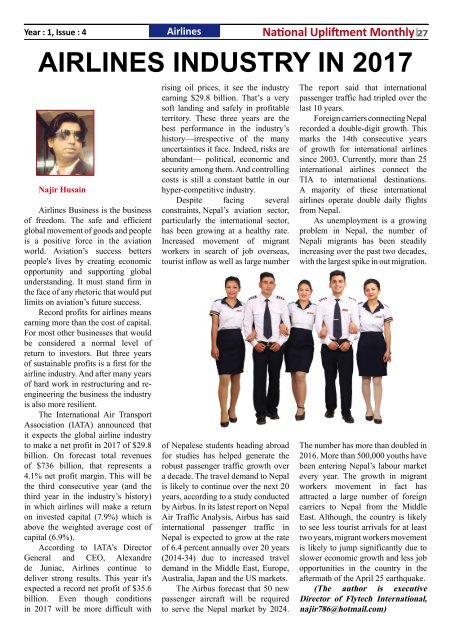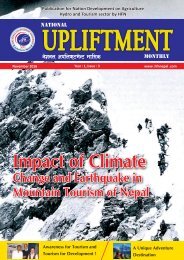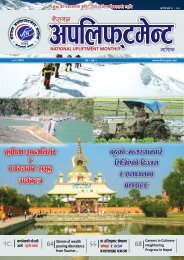Create successful ePaper yourself
Turn your PDF publications into a flip-book with our unique Google optimized e-Paper software.
Year : 1, Issue : 4 <strong>National</strong> <strong>Upliftment</strong> <strong>Monthly</strong> 27<br />
Najir Husain<br />
Airlines Business is the business<br />
of freedom. The safe and efficient<br />
global movement of goods and people<br />
is a positive force in the aviation<br />
world. Aviation’s success betters<br />
people's lives by creating economic<br />
opportunity and supporting global<br />
understanding. It must stand firm in<br />
the face of any rhetoric that would put<br />
limits on aviation’s future success.<br />
Record profits for airlines means<br />
earning more than the cost of capital.<br />
For most other businesses that would<br />
be considered a normal level of<br />
return to investors. But three years<br />
of sustainable profits is a first for the<br />
airline industry. And after many years<br />
of hard work in restructuring and reengineering<br />
the business the industry<br />
is also more resilient.<br />
The International Air Transport<br />
Association (IATA) announced that<br />
it expects the global airline industry<br />
to make a net profit in 2017 of $29.8<br />
billion. On forecast total revenues<br />
of $736 billion, that represents a<br />
4.1% net profit margin. This will be<br />
the third consecutive year (and the<br />
third year in the industry’s history)<br />
in which airlines will make a return<br />
on invested capital (7.9%) which is<br />
above the weighted average cost of<br />
capital (6.9%).<br />
According to IATA’s Director<br />
General and CEO, Alexandre<br />
de Juniac, Airlines continue to<br />
deliver strong results. This year it's<br />
expected a record net profit of $35.6<br />
billion. Even though conditions<br />
in 2017 will be more difficult with<br />
Airlines<br />
AIRLINES INDUSTRY IN 2017<br />
rising oil prices, it see the industry<br />
earning $29.8 billion. That’s a very<br />
soft landing and safely in profitable<br />
territory. These three years are the<br />
best performance in the industry’s<br />
history—irrespective of the many<br />
uncertainties it face. Indeed, risks are<br />
abundant— political, economic and<br />
security among them. And controlling<br />
costs is still a constant battle in our<br />
hyper-competitive industry.<br />
Despite facing several<br />
constraints, Nepal’s aviation sector,<br />
particularly the international sector,<br />
has been growing at a healthy rate.<br />
Increased movement of migrant<br />
workers in search of job overseas,<br />
tourist inflow as well as large number<br />
of Nepalese students heading abroad<br />
for studies has helped generate the<br />
robust passenger traffic growth over<br />
a decade. The travel demand to Nepal<br />
is likely to continue over the next 20<br />
years, according to a study conducted<br />
by Airbus. In its latest report on Nepal<br />
Air Traffic Analysis, Airbus has said<br />
international passenger traffic in<br />
Nepal is expected to grow at the rate<br />
of 6.4 percent annually over 20 years<br />
(2014-34) due to increased travel<br />
demand in the Middle East, Europe,<br />
Australia, Japan and the US markets.<br />
The Airbus forecast that 50 new<br />
passenger aircraft will be required<br />
to serve the Nepal market by 2024.<br />
The report said that international<br />
passenger traffic had tripled over the<br />
last 10 years.<br />
Foreign carriers connecting Nepal<br />
recorded a double-digit growth. This<br />
marks the 14th consecutive years<br />
of growth for international airlines<br />
since 2003. Currently, more than 25<br />
international airlines connect the<br />
TIA to international destinations.<br />
A majority of these international<br />
airlines operate double daily flights<br />
from Nepal.<br />
As unemployment is a growing<br />
problem in Nepal, the number of<br />
Nepali migrants has been steadily<br />
increasing over the past two decades,<br />
with the largest spike in out migration.<br />
The number has more than doubled in<br />
2016. More than 500,000 youths have<br />
been entering Nepal’s labour market<br />
every year. The growth in migrant<br />
workers movement in fact has<br />
attracted a large number of foreign<br />
carriers to Nepal from the Middle<br />
East. Although, the country is likely<br />
to see less tourist arrivals for at least<br />
two years, migrant workers movement<br />
is likely to jump significantly due to<br />
slower economic growth and less job<br />
opportunities in the country in the<br />
aftermath of the April 25 earthquake.<br />
(The author is executive<br />
Director of Flytech International,<br />
najir786@hotmail.com)





